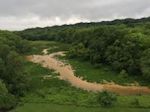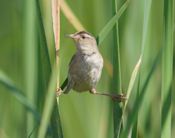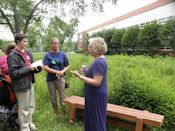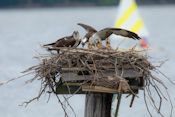On July 1, 2017, several FODMers and members of the Westgrove PACK (Pumphouse Association for Canine Kindness), the dog park friends’ group, visited the completed Quander Road outfall project, west of the dog park and Dyke Marsh West.
This year, 2017, there seem to be more marsh wrens (Cistothorus palustris) occupying the Dyke Marsh Wildlife Preserve than at any time since 2014 when FODMers last recorded this bird as a breeder. Data from volunteers this year suggest there may be as many as five territorial males in the marsh. This does not necessarily mean the population is recovering. Avian males appear more willing to occupy degraded or marginal habitats than females and, sadly, we have had no reports of females alone or as part of a breeding pair in Dyke Marsh since 2014.
It was all about geology, plants, forests, wetlands, uplands, birds, mammals, reptiles, insects, how everything interrelates and more on the June 10, 2017, ecology walk with Charles Smith, expert naturalist and Chief of Fairfax County’s Stormwater Planning Division, Watershed Projects Implementation Branch.
One of Dyke Marsh’s neighbors, the Belle View Elementary School, has created outdoor classrooms over the last ten years which help restore and support our natural resources, including the Dyke Marsh Wildlife Preserve.
The 600-student school is just west of Dyke Marsh West. What happens upstream has effects downstream, especially for water quality. For species like birds, moths and butterflies that move throughout the environment, creating some natural connectivity and supportive habitat can be very important.
An osprey (Pandion haliaetus) family near the boat ramp of the Belle Haven Marina has provided fans and photographers many prime raptor-watching opportunities this spring, 2017. The two adults are raising three young.






